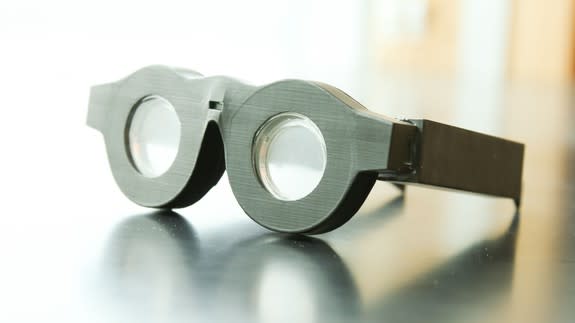This pair of glasses can change focus based on what you look at

If you need different pairs of glasses for seeing different things (say, reading vs. distance) or wear bifocals or progressive lenses, the future is looking bright: Someone has invented a pair of glasses with lenses that can adjust themselves on the fly.
A team of computer and electrical engineers at the University of Utah has unveiled a device with lenses that can change focus depending on what the wearer is looking at. That means that, when you put them on, the specs will automatically adjust to give you the clearest possible vision — whether you're reading a book or trying to spot your friend from across the street.
SEE ALSO: These glasses can correct colorblindness
The lenses are made out of the liquid glycerin — a substance common in moisturizers and other beauty products — enveloped on both sides by "flexible, rubber-like membranes." The back of the membrane links to a series of three mechanical actuators that move the membrane back and forth, which changes the curve of the lens, which in turn adjusts how it refracts light to the eye.
There's also a built-in rangefinder that measures the distance of the object that a wearer is looking at from the glasses, by way of infrared light. That tells the actuator to how to shape the lens depending on whether the wearer needs things up close or far away.

Image: Courtesy of Carlos Mastrangelo
Like any new gadget, the "smart" glasses have an app component. You enter your prescription information via an app, which communicates the info to the lens via Bluetooth. You only need to do this once (unless your prescription changes).

Image: Dan Hixson/University of Utah College of Engineering
As you can see, these glasses don't exactly look like your typical fashionable specs — though given the how popular "nerd" glasses have become with certain people, we can't completely rule out the possibility of the glasses' relative bulk to be an asset. The prototype made its debut earlier this year at CES, but inventor Carlos Mastrangelo, who led the project, said consumers would likely be able to buy a "lighter, more attractive pair" sometime in the next three years.
There are obviously other issues with this device: It seemingly promises an end to swapping out glasses when your prescription changes, but people swap out glasses for fashion reasons, too. Also, as the specs are powered by batteries, this is, yes, yet another gadget you need to charge. The mechanical nature of this device also means that if damage occurs, replacement will likely be more expensive than normal glasses.
However, if the University of Utah team fulfills its promise on releasing designs that look like normal eyeglasses, it may be a great solution to lots of people. Their users are likely to be those who skew towards the older side, as they tend to be the demographic with the need for bifocal lenses. That is, assuming they don't mind not having a variety of frames to choose from, and that swapping lenses is a problem they deem annoying enough to need solving. So, bugs to work out.

 Yahoo News
Yahoo News 